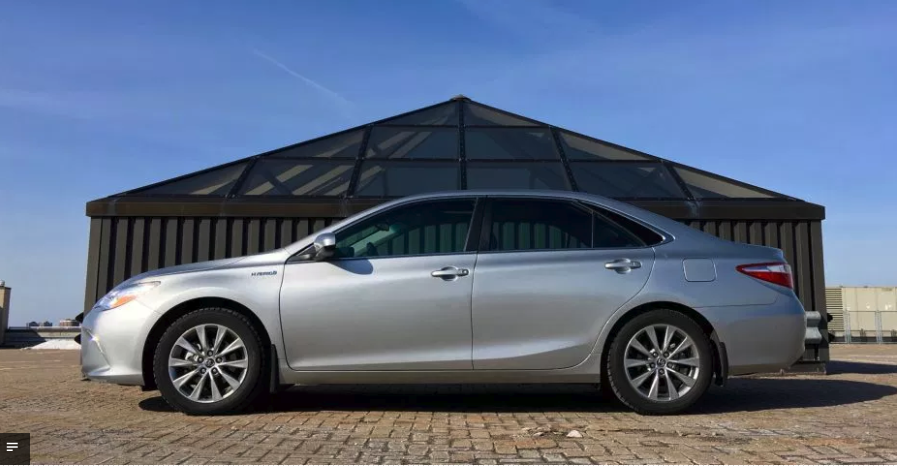Road Test: 2016 Toyota Camry Hybrid XLE

Story and photo by John LeBlanc
It’s hard to imagine, but 2017 will mark the 20th anniversary of the debut of Toyota’s first gasoline-electric hybrid vehicle, the Prius, way back in 1997. Since then, hybrids, and the electrification of the automobile, in general, have become almost ho-hum.
Yes, some still get excited about the idea of a “$35,000” all-electric Tesla, but electrically-assisted, internal combustion engine vehicles are becoming the norm, not the exception, in showrooms. To the point where the normcore Camry Hybrid — and rivals from Ford, Honda, Hyundai, Kia and Volkswagen — can get left off a new car buyer’s list. Yet after a week behind the wheel of our 2016 Toyota Camry Hybrid XLE, we think that would be a mistake.
Since the early 1980s, the front-wheel-drive, five-passenger, four-door Toyota sedan has been the steady hand of family sedans — a conservative, safe bet for unadventurous buyers. Following the path blazed by the iconic Prius, a hybrid Camry arrived for 2006. Although initially offered in loaded trim only, Toyota has increasingly added new hybrid models with lower prices.
For 2016, base Camry Hybrid LE models start at $29,235 (freight and pre-delivery inspection fees not included), followed by the sportier $31,610 SE and topped-off by our tester: the all-inclusive (highlighted by safety goodies like blind spot monitor, lane departure alert and dynamic radar cruise control) $36,135 XLE.
Nobody is going to mistake a Camry for a Lamborghini. But last year’s exterior and interior design refresh makes more of an attempt to keep the latest generation Toyota sedan (last fully redesigned for 2012) fresh looking against stylish hybrid family sedan competition, like the $28,749 2016 Ford Fusion and $30,095 2016 Kia Optima.
The only interior tangent the Hybrid vision takes from the gas-only Camry is in its trunk space. Toyota shoved the current hybrid’s battery pack forward to gain more trunk space than the pre-2012 iterations. Yet, as is the case with many of these hybrid family sedans, trunk space is compromised due to the extra electric hardware. Compared to the gas-only Camry, the Hybrid’s trunk is down 66 litres, to only 370.
And while the gas version gets a 60/40-split fold-down rear seat, the Camry Hybrid gets what amounts to a small pass-through. If that’s not practical enough for your family car hauling needs, know that both the new-generation $25,995 2016 Toyota Prius Liftback (697 L) and larger $28,565 2016 Toyota Prius V wagon (971 L) have more trunk space than any Camry sedan.
How many grocery bags you can get into the back of a family sedan may be one of your top priorities for the purchase of your next vehicle. But, more than likely, how much — or more accurately, how little — gas the Camry Hybrid sips is more important. In that regard, we have few complaints.
The Toyota sedan’s fuel consumption estimates are 5.7 L/100 km in the city and 6.1 on the highway. In real-world driving during our week in the Camry Hybrid, we scored an indicated 6.8 L/100 km — not bad for the late-winter temperatures we were experiencing at the time.
And even though the hybrid’s 2.5-litre four-cylinder/electric motor and continuously variable automatic transmission powertrain dates back to the 2012 redesign, it still offers a competitive 200 horsepower and 199 lb.-ft. of torque, allowing for the family sedan to scoot from zero to 100 km/h in just 7.5 seconds.
While the top priority with hybrid sedan shoppers is saving fuel and not burning rubber, Toyota is saying the latest Camry Hybrid is more of a driver’s car. But we aren’t as convinced.
With the goal to maintain a comfortable ride yet tighten handling, the changes made last year mean the Toyota hybrid isn’t the sensory deprivation chamber previous generations were. No one will mistake it for a BMW 3 Series (or a Ford Fusion Hybrid); however, there’s a bit more feedback from the Camry Hybrid sedan’s electrical steering system, and we found the Toyota doesn’t float as much over large road dips.
The characteristic whine from the Camry’s CVT whenever you touch the gas and the jerky reactions from the regenerative braking system has not been removed entirely. But hey, at least the Camry Hybrid’s transitions between gas and electric modes are class leading in their refinement.
In fact, “refined” is arguably the best adjective to describe the 2016 Toyota Camry Hybrid XLE.
Frugalists who like to drive should gravitate to a family hybrid sedan from Ford, Kia or Volkswagen. But in addition to its excellent fuel economy and more interesting exterior design, Toyota’s head start on the competition means the hybrid part of the Camry’s driving experience arguably makes it the best model to buy.





![[del.icio.us]](https://www.straight-six.com/wp-content/plugins/bookmarkify/delicious.png)
![[Digg]](https://www.straight-six.com/wp-content/plugins/bookmarkify/digg.png)
![[Facebook]](https://www.straight-six.com/wp-content/plugins/bookmarkify/facebook.png)
![[Google]](https://www.straight-six.com/wp-content/plugins/bookmarkify/google.png)
![[Reddit]](https://www.straight-six.com/wp-content/plugins/bookmarkify/reddit.png)
![[StumbleUpon]](https://www.straight-six.com/wp-content/plugins/bookmarkify/stumbleupon.png)
![[Twitter]](https://www.straight-six.com/wp-content/plugins/bookmarkify/twitter.png)
![[Email]](https://www.straight-six.com/wp-content/plugins/bookmarkify/email.png)